Experimental Study on the Application of Cementless Material with Industrial By-Products to Steam-Cured Precast Concrete Products
Abstract
:1. Introduction
2. Materials, Mix Proportions, Mixing, and Curing
2.1. Materials and Composition of IBPM
- FA and BFS, which are the major components of IBPM concrete, were proportioned to FA:BFS = 4:6 by mass;
- SF, expecting the effect of improving workability of the IBPM concrete, was added to 5% of the binder. This is because the workability of concrete with a low water–binder ratio is possibly improved by adding several percent of SF, which is extremely finer than the main particles, to increase the particle filling rate [17];
- The EX content of 6.0%, in view of the binder content (IBPM content) of around 500 kg/m3 of IBPM concrete, was selected for IBPM-1 to be nearly equivalent to the general content of 30 kg/m3 for OPC concrete. Moreover, the EX content of IBPM-2 was 11.1%, which was twice that of IBPM-1, to investigate its effect on the compressive strength of IBPM concrete;
- The content of CH (as an alkali stimulant) was around 4.0% in order to achieve good strength development based on the test results of IBPM mortar with W/B of 0.34. In this test, the specimens were subjected to steam curing, shown in Section 2.3, and the results are shown in Figure 3.
2.2. Mix Proportions of IBPM Concrete
2.3. Mixing and Curing Procedures
3. Compressive Strength of IBPM Concrete
3.1. Development of Compressive Strength
3.2. Effect of the Water–Binder Ratio on Compressive Strength
4. Durability of IBPM Concrete
4.1. Chloride Ion-Shielding Property
4.2. Resistance to Sulfuric Acid
5. Application of IBPM Concrete to Precast Concrete Products
5.1. Outline
5.2. Hume Pipes
5.3. Box Culverts
5.4. CO2 Emission of Precast Concrete with IBPM
6. Conclusions
- It is proved that IBPM concrete with compressive strength from 40 to 80 N/mm2 can be produced by high-temperature steam curing. The compressive strength of IBPM concrete is related to its binder–water ratio, with the relationships expressed by different straight lines depending on the expansive additive content.
- Increases in the binder content in IBPM concrete mixtures with decreases in the water–binder ratio can be suppressed by reducing the unit water content down to around 105–120 kg/m3.
- The chloride ion diffusion coefficient of IBPM concrete is approximately one-fifth of that of OPC concrete.
- The inner surface of the Hume pipe with IBPM concrete made by the centrifugal compaction method rarely suffers deterioration by sulfuric acid.
- From the test results of static loading on the mock-up specimens, it is suggested that precast concrete box culverts and Hume pipes with IBPM concrete have almost the same load-bearing capacities and deformation performances as those of OPC concrete.
Author Contributions
Funding
Institutional Review Board Statement
Informed Consent Statement
Data Availability Statement
Conflicts of Interest
References
- Purdon, A.O. The action of alkalis on blast-furnace slag. J. Soc. Chem. Ind. 1940, 59, 191–202. [Google Scholar]
- Provis, J.L.; van Deventer, J.S.J. (Eds.) Alkali Activated Materials; State-of-the-Art Report, RILEM TC 224-AAM; Springer: Berlin/Heidelberg, Germany, 2014. [Google Scholar] [CrossRef]
- Yang, K.-H.; Cho, A.-R.; Song, J.-K. Effect of water–binder ratio on the mechanical properties of calcium hydroxide-based alkali-activated slag concrete. Constr. Build. Mater. 2012, 29, 504–511. [Google Scholar] [CrossRef]
- Teo, W.; Shirai, K.; Lim, J.H.; Jack, L.B.; Nikbakh, E. Experimental investigation on ambient-cured one-part alkali-activated binders using combined high-calcium fly ash (HCFA) and ground granulated blast furnace slag (GGBS). Materials 2022, 15, 1612. [Google Scholar] [CrossRef]
- Duży, P.; Choinska, M.; Hager, I.; Amiri, O.; Claverie, J. Mechanical strength and chloride ions’ penetration of alkali-activated concretes (AAC) with blended precursor. Materials 2022, 15, 4475. [Google Scholar] [CrossRef]
- Lee, N.K.; Lee, H.K. Influence of the slag content on the chloride and sulfuric acid resistances of alkali-activated fly ash/slag paste. Cem. Concr. Compos. 2016, 72, 168–179. [Google Scholar] [CrossRef]
- Ren, J.; Zhang, L.; San, R. Degradation of alkali-activated slag and fly ash mortars under different aggressive acid conditions. J. Mater. Civ. Eng. 2021, 33, 04021140. [Google Scholar] [CrossRef]
- Khan, H.A.; Khan, M.S.H.; Castel, A.; Sunarho, J. Deterioration of alkali-activated mortars exposed to natural aggressive sewer environment. Constr. Build. Mater. 2018, 186, 577–597. [Google Scholar] [CrossRef]
- Ichimiya, K.; Harada, K.; Tsugo, S.; Ikeda, K. Measures against surface deterioration of street-sideway boundary blocks made of geopolymer in Beppu Myoban-Onsen hot spring. In Proceedings of the Japan Society of Civil Engineers Annual Meeting 2018, Sapporo, Japan, 29–31 August 2018; Volume 73, p. V-282. [Google Scholar]
- Sato, T.; Oki, N.; Tsukahara, M.; Uehara, M. Trial product for practical use of geopolymer block sleepers reinforced by short fiber. Proc. Jpn. Concr. Inst. 2013, 35, 2023–2025. [Google Scholar]
- Glasby, T.; Day, J.; Genrich, R.; Aldred, J. EFC geopolymer concrete aircraft pavements at Brisbane West Wellcamp Airport. In Proceedings of the 27th Concrete Institute of Australia Conference 2015, Melbourne, Australia, 30 August–2 September 2015. [Google Scholar]
- Kong, L.; Fan, Z.; Ma, W.; Lu, J.; Liu, Y. Effect of Curing Conditions on the Strength Development of Alkali-Activated Mortar. Crystals 2021, 11, 1455. [Google Scholar] [CrossRef]
- Aydin, S.; Baradan, B. Mechanical and microstructural properties of heat cured alkali-activated slag mortars. Mater. Des. 2012, 35, 374–383. [Google Scholar] [CrossRef]
- Luukkonen, T.; Abdollahnejad, Z.; Yliniemi, J.; Kinnunen, P.; Illikainen, M. One-part alkali-activated materials: A review. Cem. Concr. Res. 2018, 103, 21–34. [Google Scholar] [CrossRef]
- Suzuki, A.; Fujiwara, T.; Maruoka, M.; Iwata, M. Properties of environmental load-reducing concrete using various alkaline stimulants. Proc. Jpn. Concr. Inst. 2014, 36, 628–633. [Google Scholar]
- Horiguchi, K.; Matsumoto, J.; Kawamura, K.; Sakamoto, J. Development of Precast concrete products using low carbon type concrete. Proc. Jpn. Concr. Inst. 2016, 38, 213–218. [Google Scholar]
- Bache, H.H. Densified cement ultra-fine particle-based materials. In Proceedings of the Second International Conference on Superplasticizers in Concrete, Ottawa, ON, Canada, 10–12 June 1981; p. 35. [Google Scholar]
- Hata, M.; Sugimoto, K.; Hayashi, E.; Miyazawa, S. Fundamental Study on highly acid-resistant concrete pipes by centrifugal molding. In Proceedings of the International Conference on Regeneration and Conservation of Structures, RILEM, Kyoto, Japan, 3–9 September 2022. [Google Scholar]
- Hata, M.; Sugimoto, K.; Hayashi, E.; Iwasa, Y.; Igawa, H.; Miyazawa, S. Flexural behavior of precast reinforced concrete members with cementless concrete and its application to sewer pipes. J. JSCE 2021, 77, 164–176. [Google Scholar] [CrossRef]
- Ryu, G.S.; Choi, S.; Koh, K.T.; Ahn, G.H.; Kim, H.Y.; You, Y.J. A study on initial setting and modulus of elasticity of AAM mortar mixed with CSA expansive additive using ultrasonic pulse velocity. Materials 2020, 13, 4432. [Google Scholar] [CrossRef] [PubMed]
- JSCE-G574-2013; Area Analysis Method of Elements Distribution in Concrete by Using EPMA. Japan Society of Civil Engineers: Tokyo, Japan, 2013.
- JSCE-G572-2013; Test Method for Apparent Diffusion Coefficient of Chloride Ion in Concrete by Submergence in Salt Water. Japan Society of Civil Engineers: Tokyo, Japan, 2013.
- ASTM C1556-11a; Standard Test Method for Determining the Apparent Chloride Diffusion Coefficient of Cementitious Mixtures by Bulk Diffusion. ASTM International: West Conshohocken, PA, USA, 2016.
- Technical Manual: Corrosion Control Measures for Sewerage Concrete Structures; Japan Sewage Works Agency: Tokyo, Japan, 2017; pp. 78–84.
- Hata, M.; Sugimoto, K.; Hayashi, E.; Miyazawa, S. Basic research on the application of hardened products utilizing industrial by-products to sewer pipes. Proc. Jpn. Concr. Inst. 2020, 42, 1834–1839. [Google Scholar]
- JIS A 5372; Precast Reinforced Concrete Product. Japan Industrial Standard: Tokyo, Japan, 2016.
- JSWAS A-1; Reinforced Concrete Pipes Products for Sewerage. Japan Sewerage Association: Tokyo, Japan, 2003.
- JSWAS A-2; Reinforced Concrete Pipes for Sewerage Propulsion Methods. Japan Sewerage Association: Tokyo, Japan, 2003.
- JSWAS A-2; Reinforced Concrete Box Culverts for Sewerage. Japan Sewerage Association: Tokyo, Japan, 2012.
- Japan Society of Civil Engineers. Recommendation for design and construction of concrete structures containing high-volume mineral admixtures. Concr. Libr. 2018, 152, 140. [Google Scholar]
- Sugabayashi, K. Environmental impact assessment of construction based on the infrastructure LCA. Nippon Koei Tech. Forum 2014, 22, 61–67. [Google Scholar]

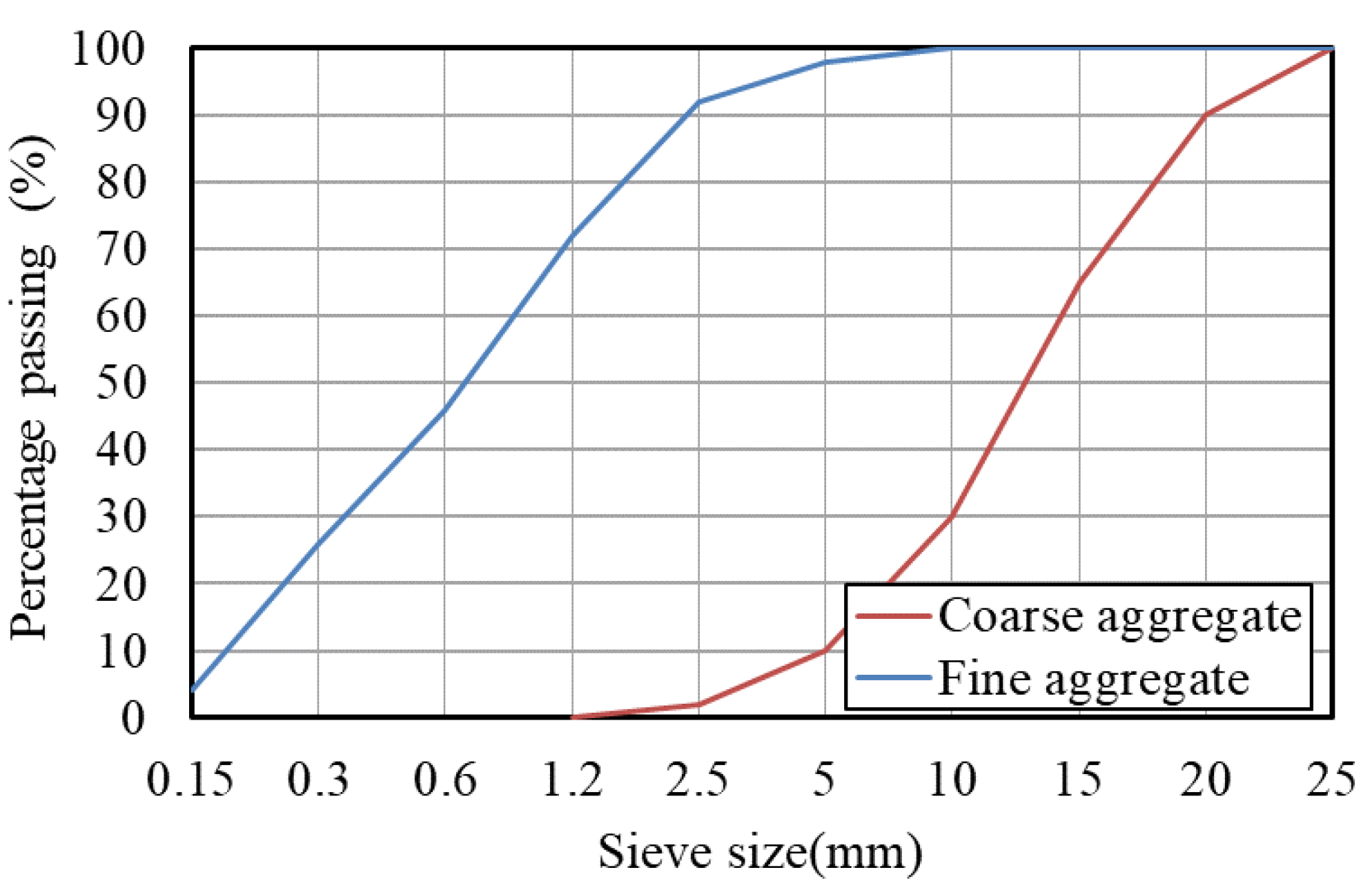


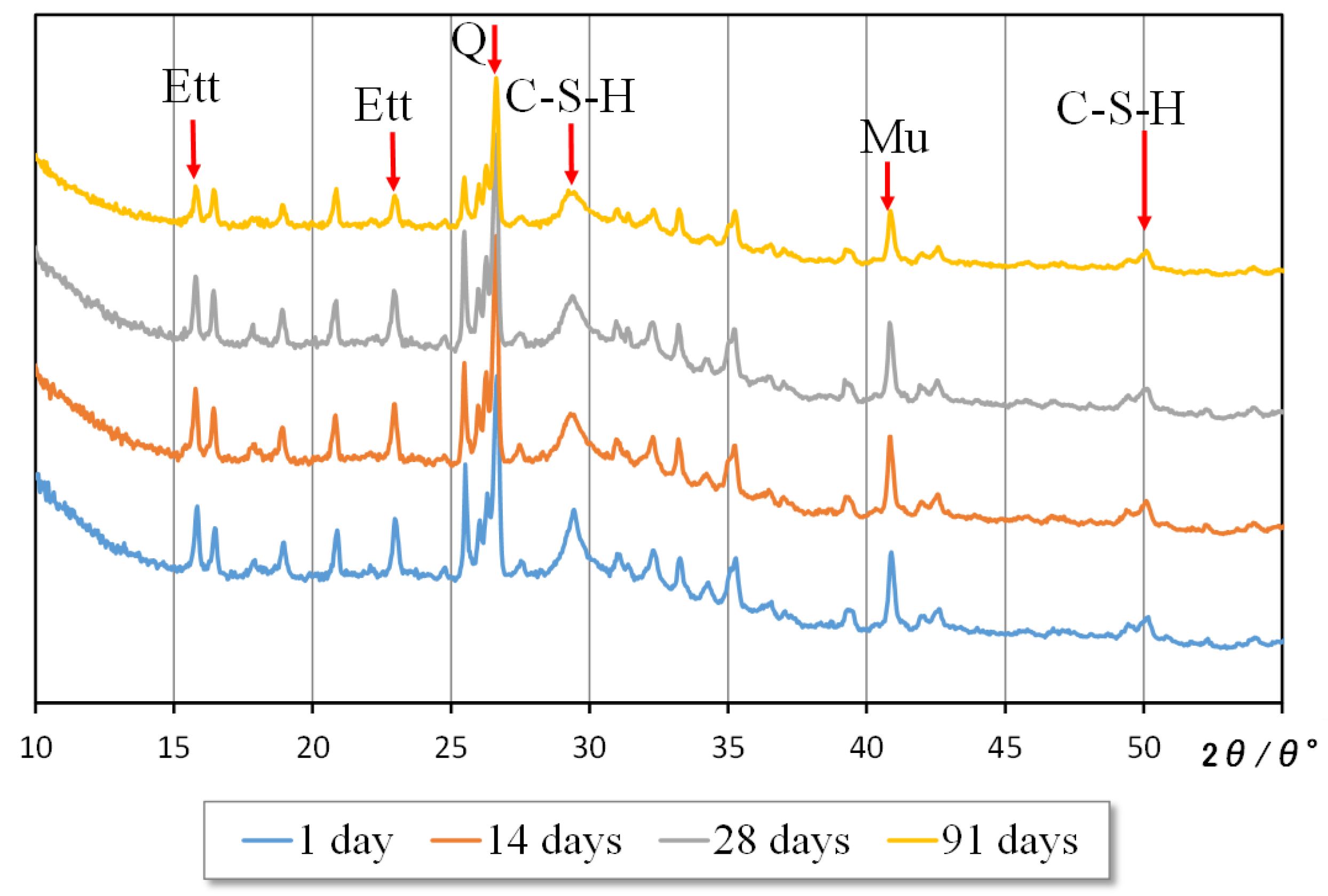
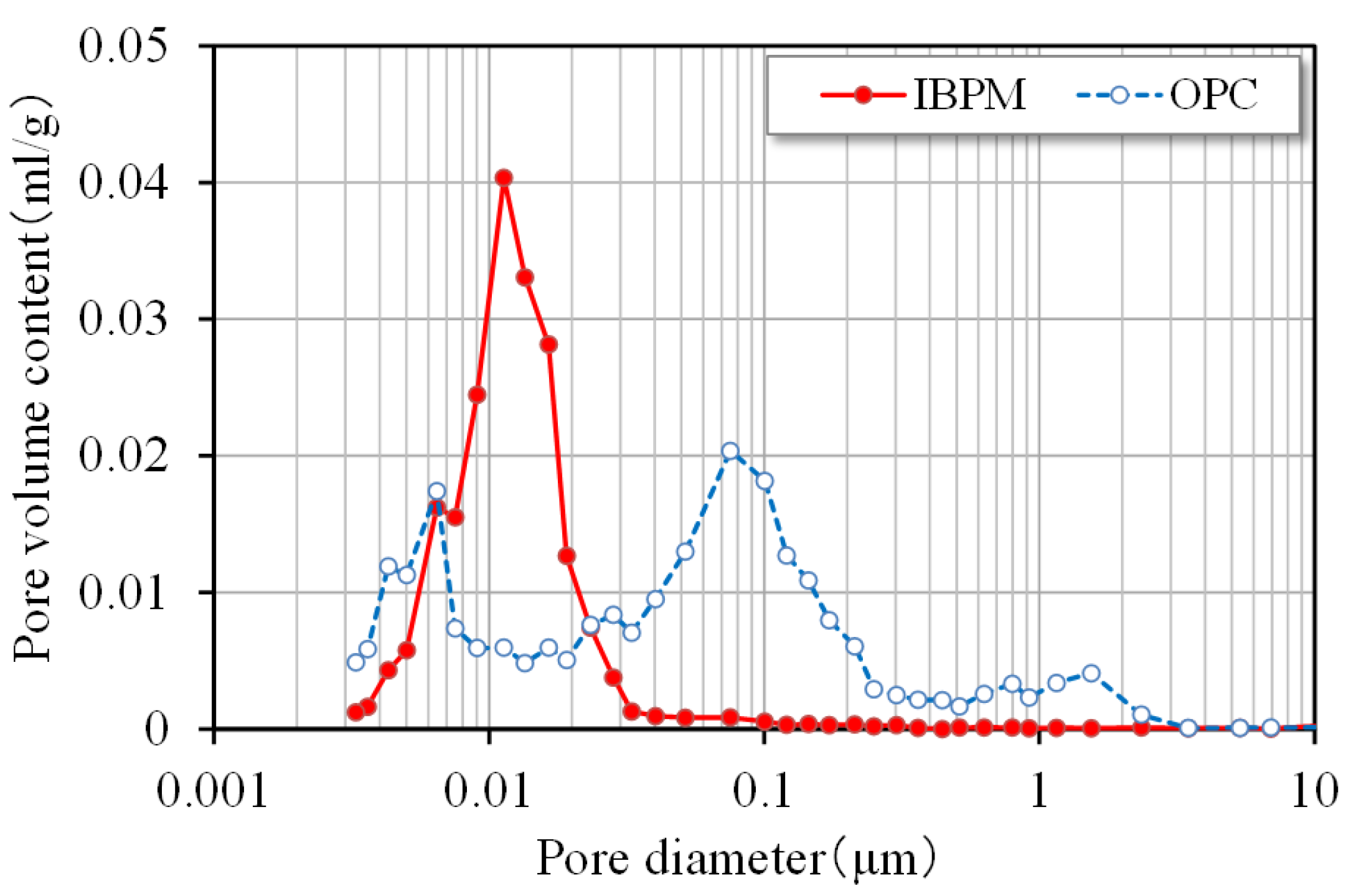
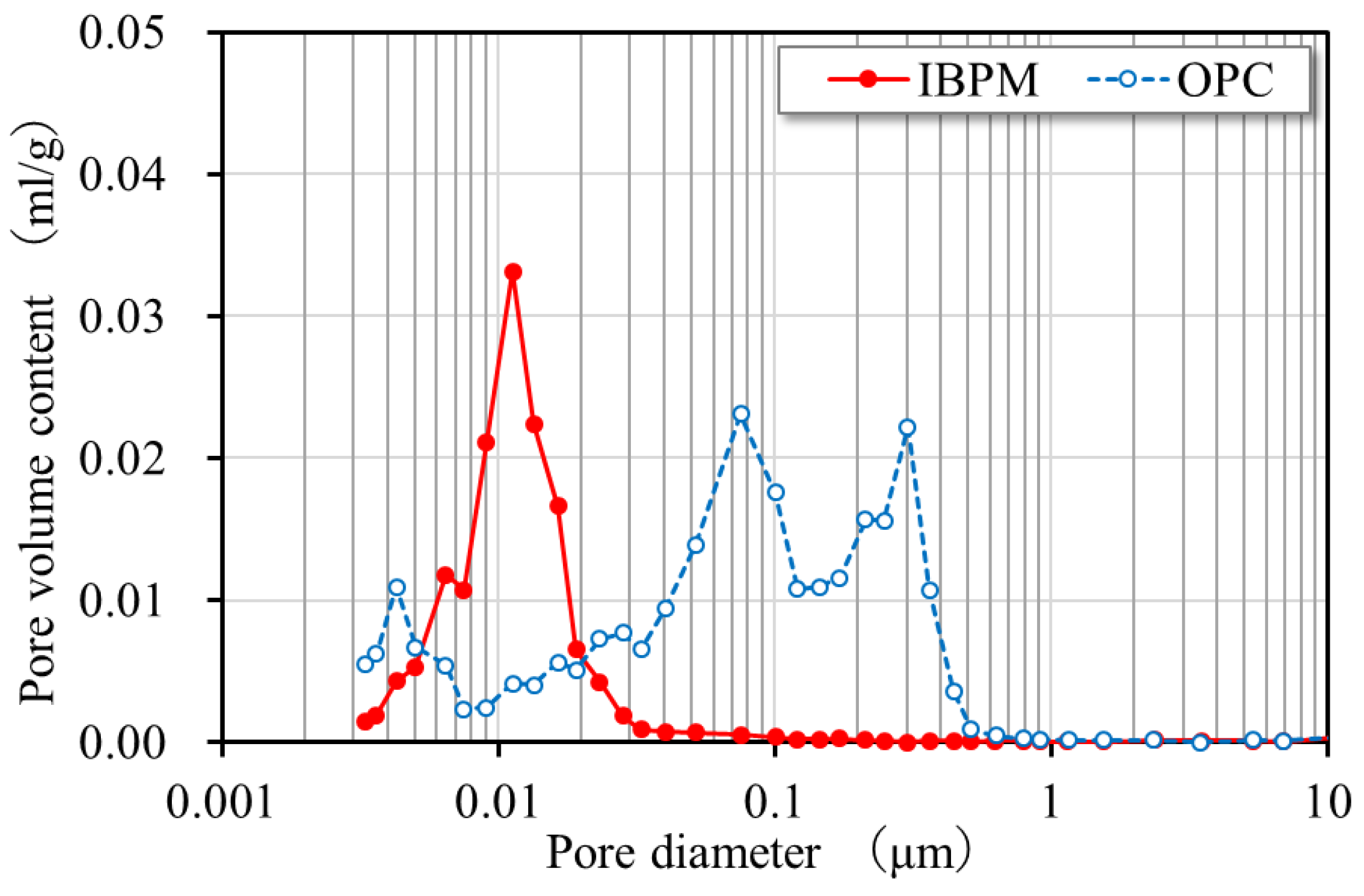
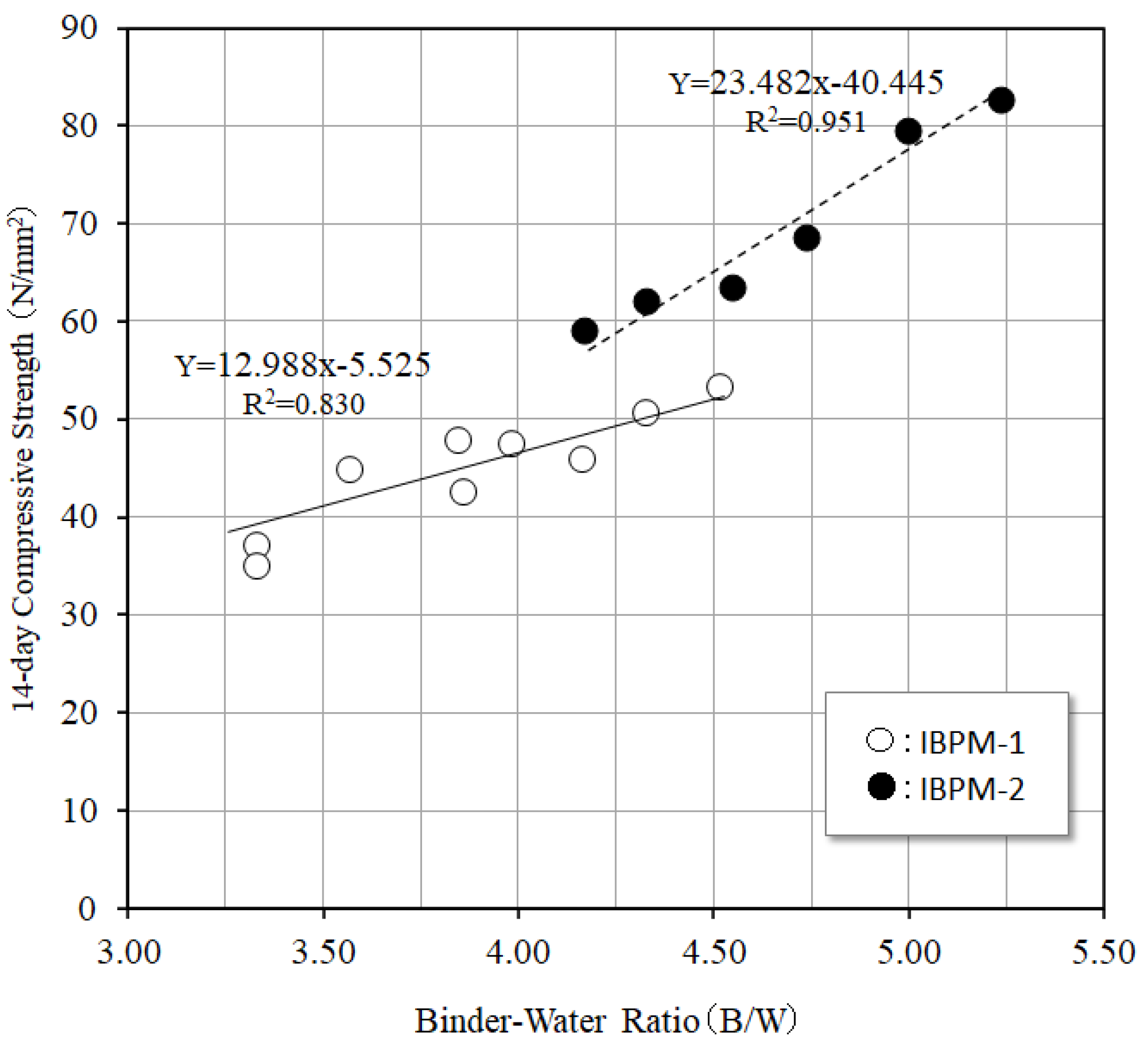

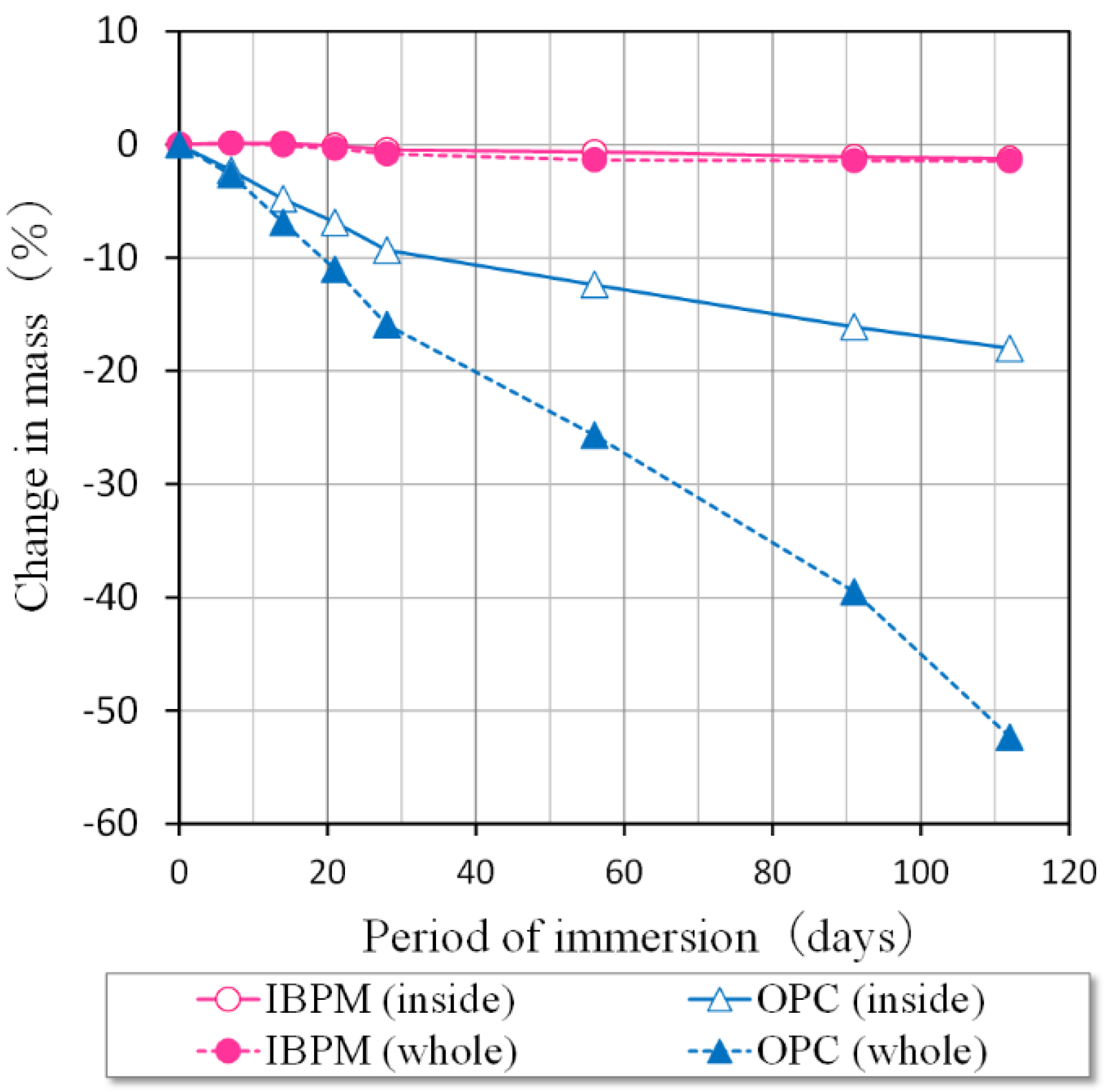

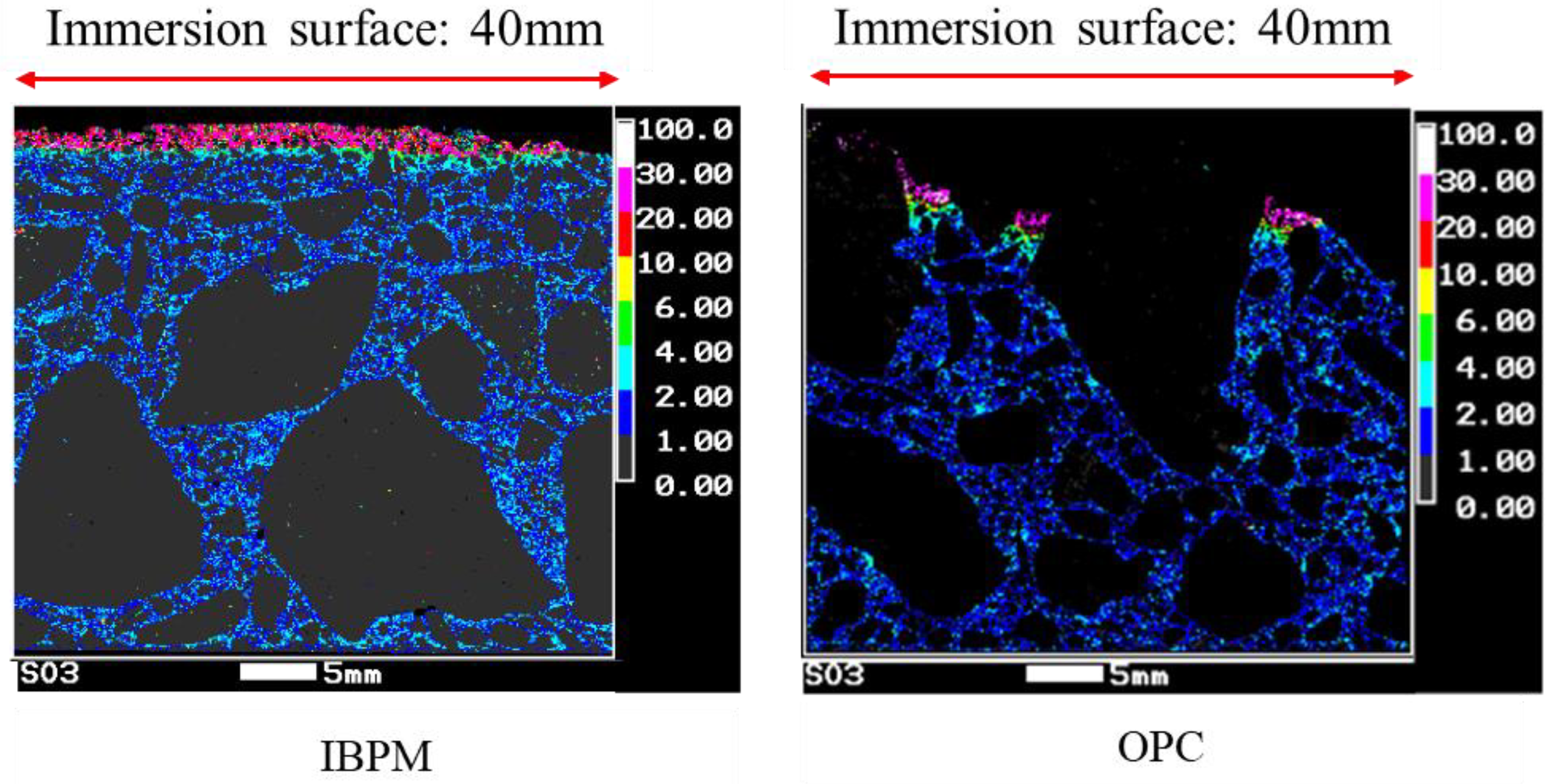
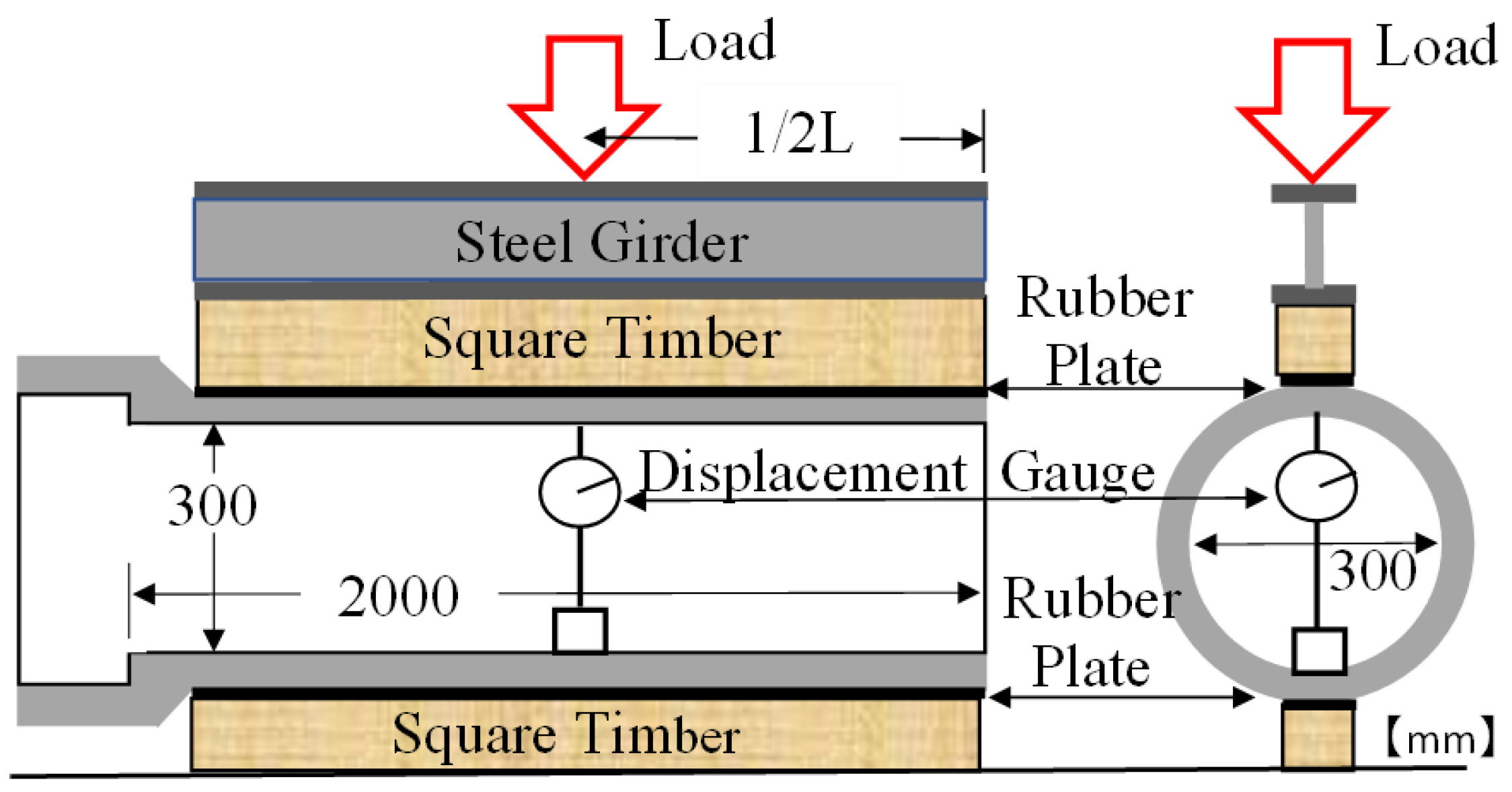
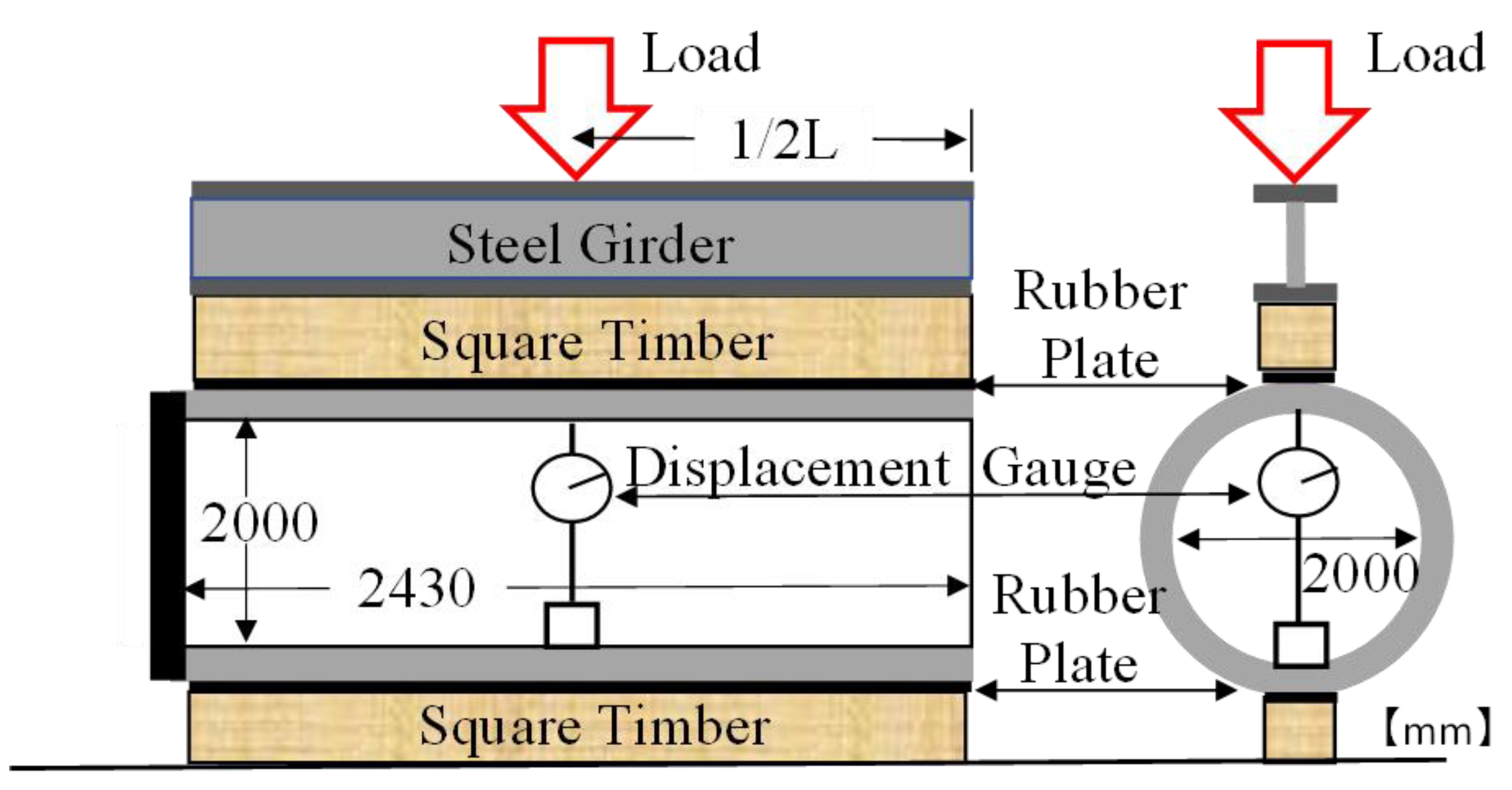
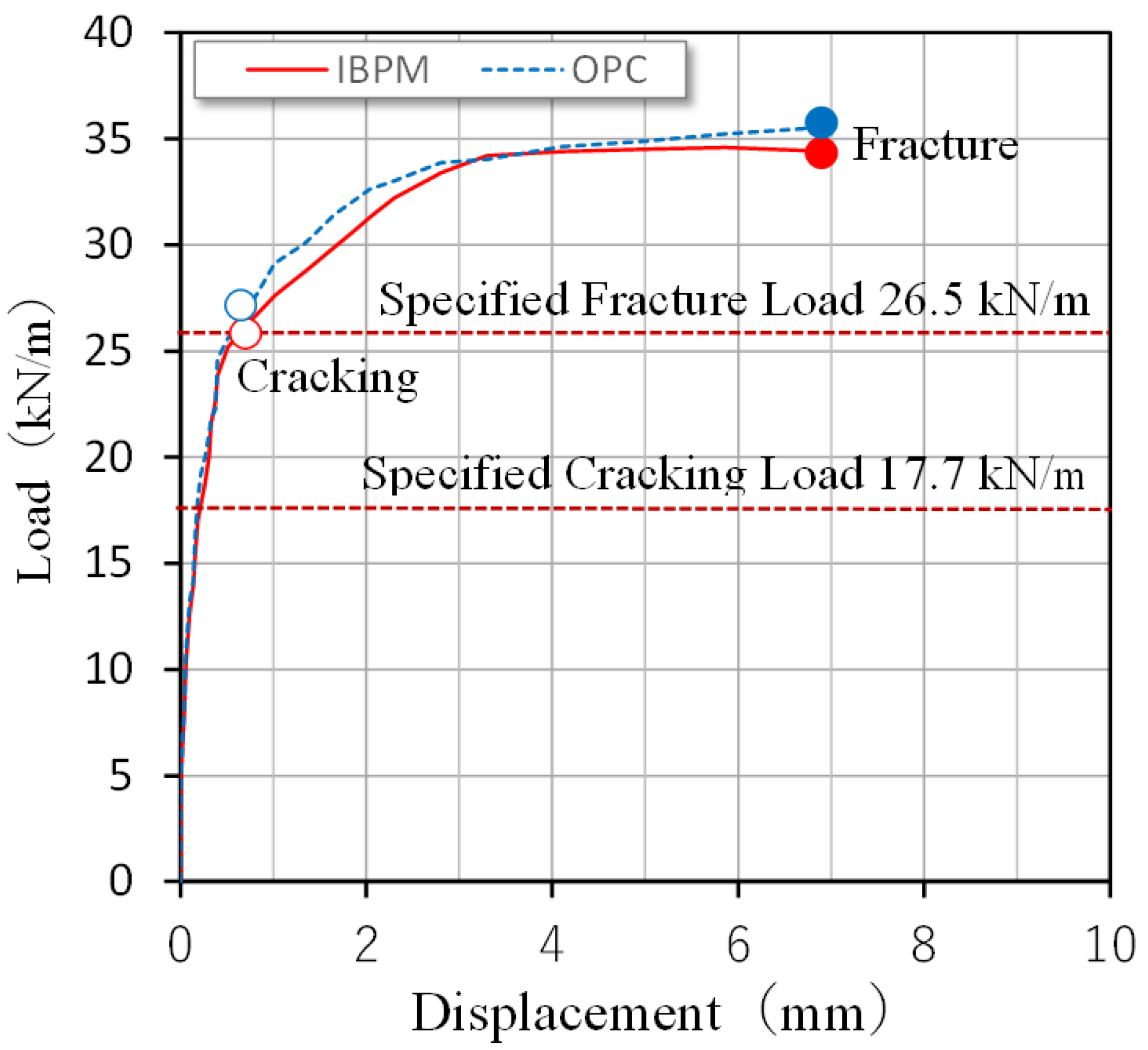
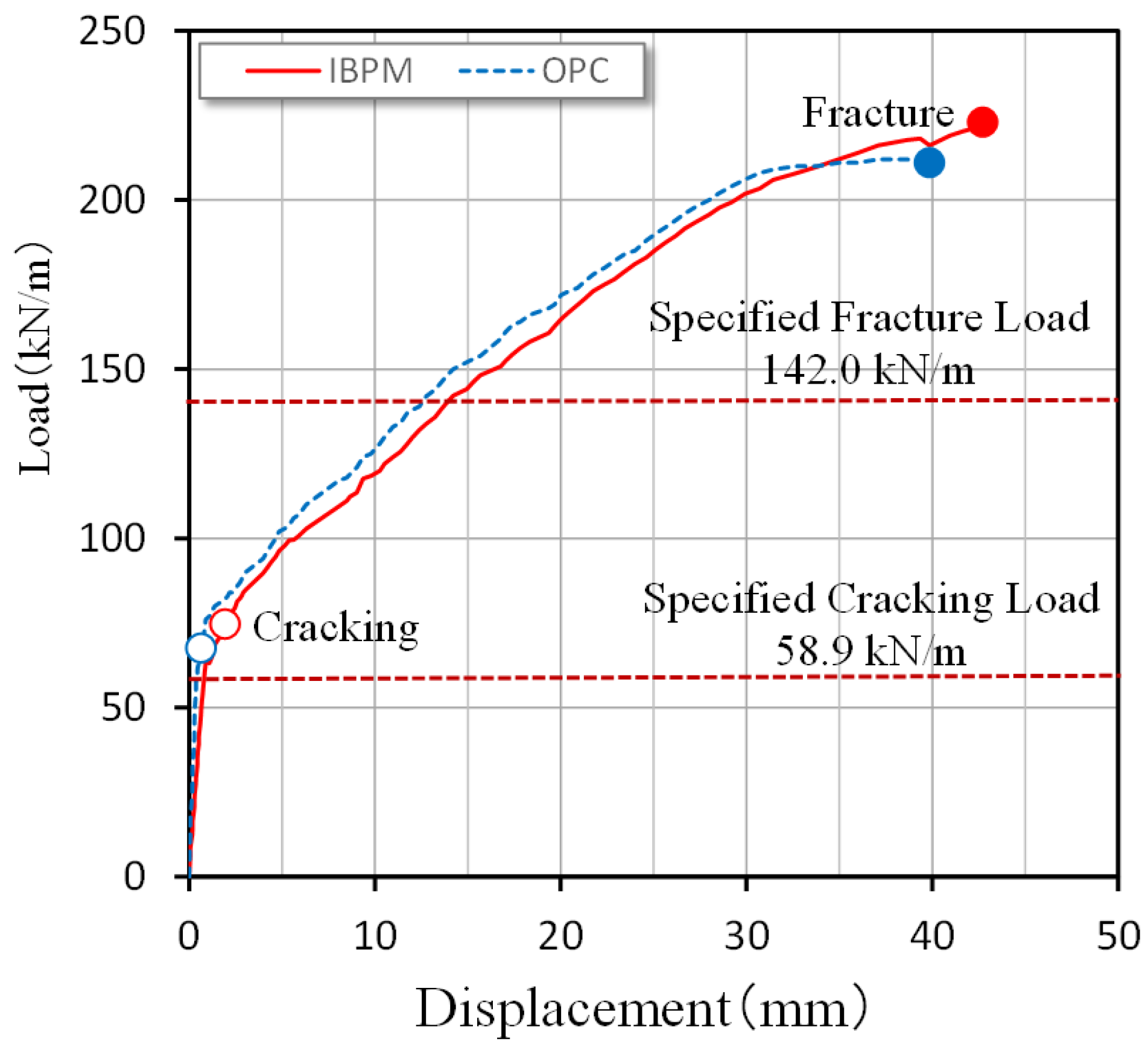
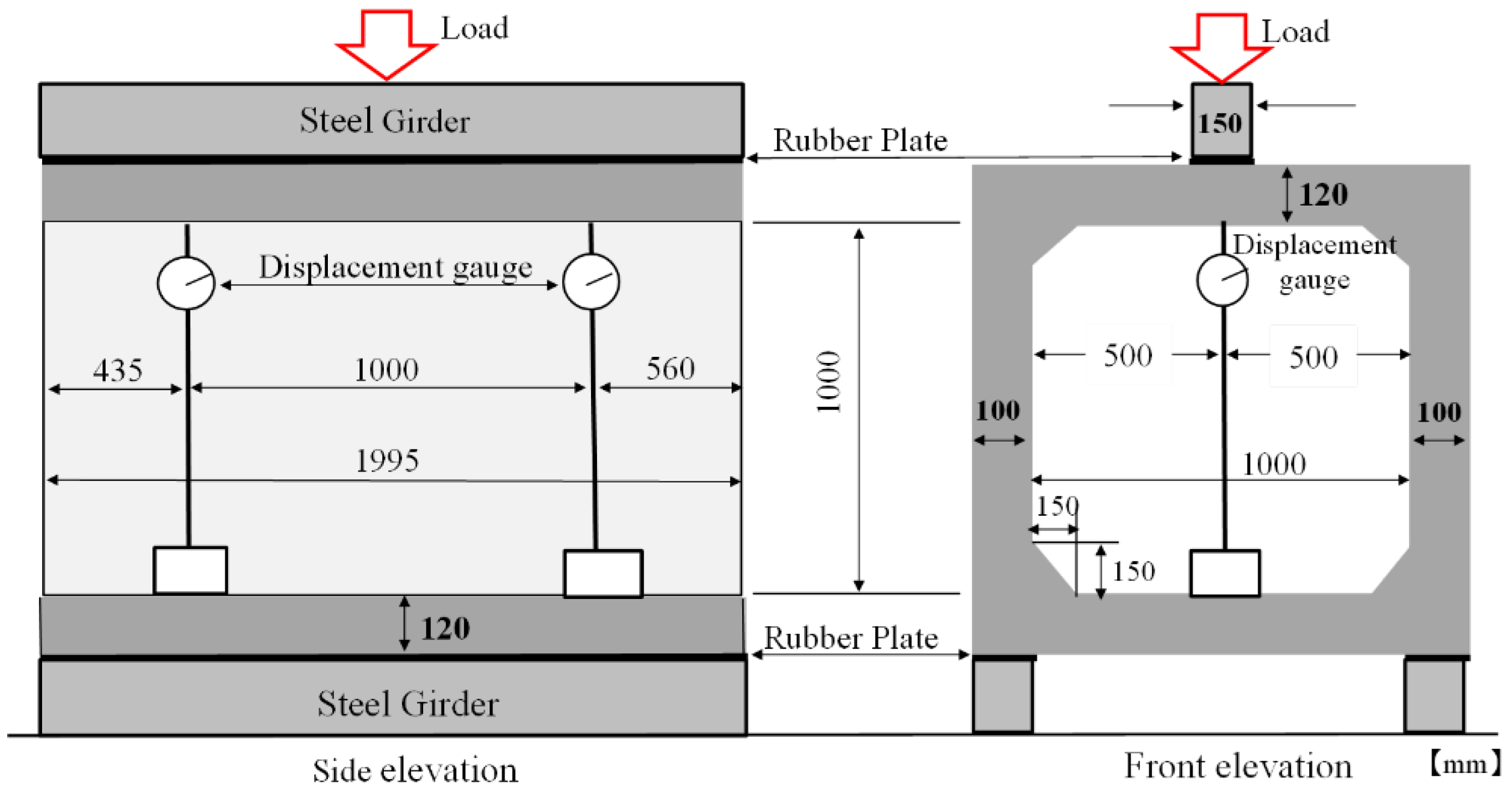
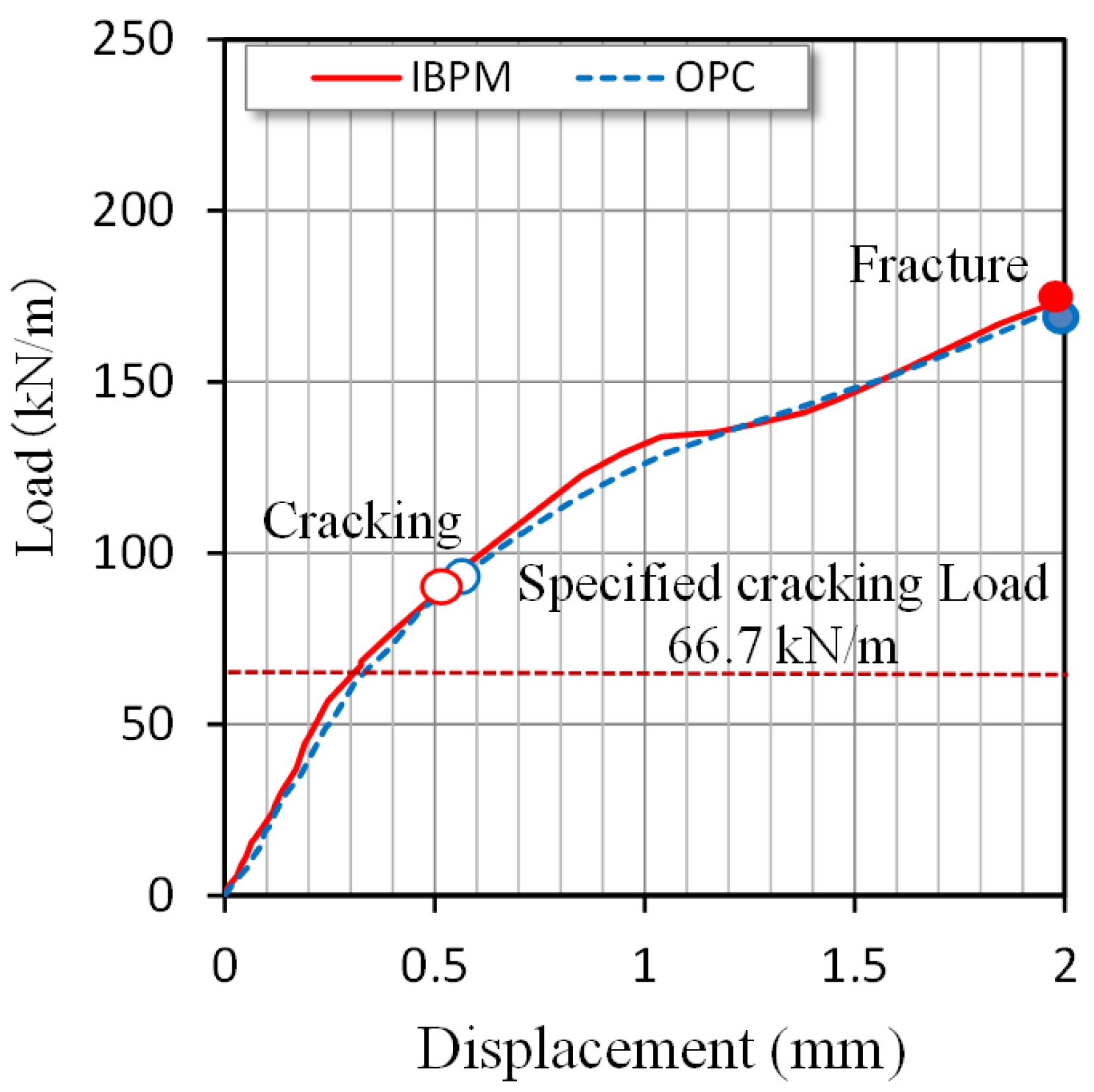
| Material | Symbol | Density (g/cm3) | Specific Surface Area (cm2/g) | Activity Index at 28 Days (%) |
|---|---|---|---|---|
| Fly ash | FA | 2.20 | 3480 | 81 |
| Ground granulated blast furnace slag | BFS | 2.91 | 4230 | 92 |
| Silica fume | SF | 2.30 | 191,000 | 110 |
| Expansive additive | EX | 3.15 | 4560 | - |
| Calcium hydroxide | CH | 2.32 | 150,000 | - |
| Material | Ig. Loss (%) | Chemical Composition (%) | |||||||||
|---|---|---|---|---|---|---|---|---|---|---|---|
| SiO2 | Al2O3 | Fe2O3 | CaO | MgO | SO3 | Na2O3 | K2O | TiO2 | P2O5 | ||
| FA | 2.63 | 52.78 | 29.05 | 4.12 | 3.79 | 1.90 | 0.26 | 0.50 | 1.09 | 1.59 | 0.41 |
| BFS | 0.08 | 34.03 | 14.69 | 0.41 | 42.90 | 6.01 | - | 0.22 | 0.32 | 0.55 | 0.01 |
| SF | 3.71 | 92.97 | - | - | - | 0.37 | 0.65 | - | - | - | - |
| EX | 4.40 | 4.43 | 1.36 | 0.67 | 60.36 | 0.64 | 27.28 | 0.12 | 0.11 | 0.07 | 0.11 |
| CH | 24.76 | 0.19 | 0.11 | 0.12 | 73.82 | 0.77 | 0.07 | ND | 0.01 | 0.02 | 0.03 |
| Classification | Kind | Density (g/cm3) | Absorption (%) | Solid Content (%) | Fineness Modulus | Rock Type |
|---|---|---|---|---|---|---|
| Fine aggregate | Crushed sand | 2.62 | 1.76 | 65.5 | 2.64 | Tight sandstone |
| Coarse aggregate | Crushed stone | 2.67 | 1.51 | 58.2 | 6.69 |
| Type | Blend Ratio (%) | |||||
|---|---|---|---|---|---|---|
| FA | BFS | SF | EX | CH | Total | |
| IBPM-1 | 33.0 | 51.0 | 6.0 | 6.0 | 4.0 | 100.0 |
| IBPM-2 | 31.3 | 48.2 | 5.6 | 11.1 | 3.8 | 100.0 |
| No. | IBPM Type | W/B | s/a (%) | Unit Content (kg/m3) | Air (%) | Slump Flow/ (Slump) (cm) | Remark | ||||
|---|---|---|---|---|---|---|---|---|---|---|---|
| W | IBPM | S | G | Sp | |||||||
| 1 | 1 | 0.300 | 45 | 150 | 500 | 750 | 934 | 6.00 | 1.6 | 53.5 | - |
| 2 | 1 | 0.300 | 41 | 120 | 400 | 757 | 1111 | 5.20 | 1.6 | (16.5) | - |
| 3 | 1 | 0.280 | 45 | 112 | 400 | 841 | 1066 | 5.60 | 1.7 | 48.0 | - |
| 4 | 1 | 0.260 | 45 | 130 | 500 | 773 | 982 | 5.00 | 1.4 | 54.5 | - |
| 5 | 1 | 0.259 | 41 | 114 | 440 | 747 | 1095 | 6.60 | 1.4 | (8.0) | Hume Pipe A |
| 6 | 1 | 0.251 | 41 | 138 | 550 | 678 | 994 | 6.60 | 1.6 | 54.0 | - |
| 7 | 1 | 0.240 | 41 | 132 | 550 | 681 | 1001 | 6.60 | 1.7 | 53.5 | - |
| 8 | 1 | 0.231 | 41 | 127 | 550 | 686 | 1009 | 6.60 | 1.8 | 53.0 | - |
| 9 | 1 | 0.221 | 41 | 124 | 560 | 686 | 1007 | 7.28 | 1.6 | 53.5 | - |
| 10 | 2 | 0.240 | 41 | 120 | 500 | 715 | 1049 | 8.00 | 1.5 | 62.0 | - |
| 11 | 2 | 0.231 | 41 | 120 | 520 | 707 | 1036 | 8.58 | 1.4 | 63.5 | - |
| 12 | 2 | 0.220 | 41 | 108 | 490 | 734 | 1076 | 7.84 | 1.4 | 55.5 | Hume Pipe B |
| 13 | 2 | 0.211 | 45 | 116 | 550 | 770 | 959 | 10.18 | 1.5 | 58.0 | Box Culvert |
| 14 | 2 | 0.200 | 41 | 110 | 550 | 707 | 1039 | 9.90 | 1.7 | 55.5 | - |
| 15 | 2 | 0.191 | 41 | 105 | 550 | 713 | 1046 | 11.83 | 1.9 | 54.0 | - |
| Item | Set Condition |
|---|---|
| Pre-curing time | 6 h |
| Heating rate | 20 °C/h |
| Maximum temperature | 65 °C |
| Maximum temperature-keeping time | 4 h |
| Cooling conditions | Natural cooling |
| Binder | Thickness of Specimen (mm) | Depth of Scaled Portion (mm) | Sulfur Penetration (mm) | |
|---|---|---|---|---|
| Before Immersion | After Immersion | |||
| IBPM | 40.5 | 39.0 | 1.5 | 7 |
| OPC | 40.4 | 33.3 | 7.1 | 15 |
| Item | First Stage | Second Stage | Third Stage |
|---|---|---|---|
| Acceleration G: gravitational acceleration | 5 G | 15 G | 35 G |
| Centrifugal compaction time | 1 min | 1 min | 7 min |
| Products | Item | Cracking Load (kN/m) | Fracture Load (kN/m) | Compressive Strength (N/mm2) |
|---|---|---|---|---|
| Hume pipe A | Specified value | 17.7 | 26.5 | - |
| Observed (IBPM) | 26.1 | 34.6 | 45.6 | |
| Observed (OPC) | 27.9 | 35.6 | 46.5 | |
| Hume pipe B | Specified value | 58.9 | 142.0 | - |
| Observed (IBPM) | 65.4 | 222.2 | 58.2 | |
| Observed (OPC) | 59.3 | 211.0 | 56.7 |
| Item | Cracking Load (kN/m) | Fracture Load (kN/m) | Compressive Strength (N/mm2) | Tensile Strength (N/mm2) | Flexural Strength (N/mm2) | Modulus of Elasticity (kN/mm2) |
|---|---|---|---|---|---|---|
| Specified value | 66.7 | - | 50.0 | - | - | - |
| Observed (IBPM) | 96.2 | 399.4 | 59.9 | 4.1 | 5.4 | 35.3 |
| Observed (OPC) | 96.9 | 392.0 | 55.5 | 3.8 | 5.4 | 33.4 |
| Materials | CO2 Emission Intensity (kg-CO2/t) | Blend Ratio (%) | CO2 Emission (kg-CO2/t) |
|---|---|---|---|
| FA | 19.6 | 31.3 | 6.1 |
| BFS | 26.5 | 48.2 | 12.8 |
| SF | 19.6 | 5.6 | 1.1 |
| EX | 764.3 | 11.1 | 84.8 |
| CH | 844.6 | 3.8 | 32.1 |
| Total | 2.9 | 100.0 | 136.9 |
Publisher’s Note: MDPI stays neutral with regard to jurisdictional claims in published maps and institutional affiliations. |
© 2022 by the authors. Licensee MDPI, Basel, Switzerland. This article is an open access article distributed under the terms and conditions of the Creative Commons Attribution (CC BY) license (https://creativecommons.org/licenses/by/4.0/).
Share and Cite
Hata, M.; Sato, M.; Miyazawa, S. Experimental Study on the Application of Cementless Material with Industrial By-Products to Steam-Cured Precast Concrete Products. Materials 2022, 15, 7624. https://doi.org/10.3390/ma15217624
Hata M, Sato M, Miyazawa S. Experimental Study on the Application of Cementless Material with Industrial By-Products to Steam-Cured Precast Concrete Products. Materials. 2022; 15(21):7624. https://doi.org/10.3390/ma15217624
Chicago/Turabian StyleHata, Minoru, Makoto Sato, and Shingo Miyazawa. 2022. "Experimental Study on the Application of Cementless Material with Industrial By-Products to Steam-Cured Precast Concrete Products" Materials 15, no. 21: 7624. https://doi.org/10.3390/ma15217624
APA StyleHata, M., Sato, M., & Miyazawa, S. (2022). Experimental Study on the Application of Cementless Material with Industrial By-Products to Steam-Cured Precast Concrete Products. Materials, 15(21), 7624. https://doi.org/10.3390/ma15217624




